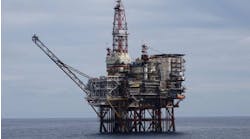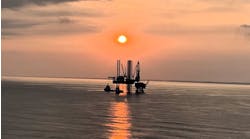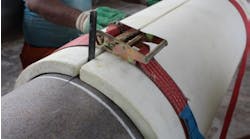Oilfield service sector continues to innovate amidst downturn
Even as low oil prices continue to dampen E&P activity, engineering firms and downhole service providers are developing new products and technologies that can help drillers and producers operate more efficiently. A number of these new technologies were unveiled at the recent International Association of Drilling Contractors/ Society of Petroleum Engineers (IADC/SPE) annual conference.
Smith Bits, a Schlumberger company, announced the release of the AxeBlade ridged diamond element bit, which incorporates new-geometry Axe ridged diamond elements across the bit face. The company says that AxeBlade bits improve rate of penetration (ROP) in a wide range of formations and steering response in directional applications.
The latest generation of Smith Bits three-dimensional cutting technologies, Axe elements have what the company calls “a distinctive ridge shape” that combines the shearing action of a conventional PDC bit with the crushing action of a roller cone bit. The geometry of the element bit is designed to break rock more efficiently, requiring 30% less force. The new bit is also said to deliver improved control compared with conventional PDC cutters when drilling directionally.
Smith Bits says that the AxeBlade bit has been successfully field tested in a variety of applications, drilling more than a cumulative total of 200,000 ft [60,960 m]. In a field trial in South Texas, the AxeBlade bit kicked off from vertical to a 90° angle and continued drilling the lateral section for a total of 3,586 ft [1,093 m] with 29% faster ROP compared to offset wells.
Schlumberger also introduced its new new MaxPull 30000 wireline conveyance system at the IADC/SPE event.
Technical experts from Schlumberger were on hand to discuss the company’s new MaxPull 30000 wireline conveyance system. Currently at work in the Gulf of Mexico, Schlumberger highlighted the large-scale second-generation system at IADC/SPE, where it necessitated its own booth space on the show floor. It can be deployed as a standard conveyance system or be customized to work optimally well configurations on and offshore, Serko Sarian, telemetry and conveyance manager, Schlumberger said.
As the industry progresses to drill deeper wells, the challenge in acquiring the data necessary for reservoir characterization increases along with the water depth. Ultra-deepwater wells 40,000 ft and deeper could require 30,000 pound-force (lbf) of pull capability to ensure adequate overpull to reduce sticking risk. Speaking to Offshore, Sarian said that the MaxPull high-pull system, which can safely pull up to 30,000 lbf, allows operators to log wells in the Gulf of Mexico deeper than 36,000 ft.
He continued by saying that the MaxPull conveyance system is able to reduce risk and tool-sticking, which itself could cost about $4 million in rig-time spent on a four-day fishing operation.
The MaxPull 30000 utilizes Schlumberger’s TuffLINE 30000 composite cable, which has polymer-locker armors and thickened inner armor strands to balance its inherent torque. The company says it can withstand temperatures of 450°F (232°C) in a 24-hour period. The OSU-N offshore unit deploys the cable from a 43,000-ft capacity WDR-70 drum.
The MaxPull system was actually the subject of a Schlumberger-authored paper presented at IADC/SPE. The MaxPull 26000 system has been deployed in the Gulf of Mexico since October 2014, providing a 25% increase in pull over the conventional 21,000 system. By enabling pulls exceeding 21,000 lbf, the MaxPull 26000 system made it possible to prevent four instances of otherwise unavoidable fishing incidents, saving more than 12 deepwater fishing days and $9 million of rig time, the author explained.
Elsewhere, the Cross Group recently announced that its newly launched subsea well intervention package has been successfully deployed in the Gulf of Mexico. In early April, the company said that it had completed subsea live well intervention operations on three through flowline (TFL) template wells in the US GoM using its 3-1/16-in., 10,000-psi subsea convertible live well intervention package in 1,800 ft of water.
The company deployed the intervention package in the riserless configuration on two of the TFL template wells from a DP2 multi-service vessel. The third TFL template well operation was conducted from the client’s DP-2 semisubmersible rig, where the subsea well intervention package was deployed in a riser-based configuration. The Cross Group said that each well was successfully completed without incident to personnel or equipment.
Statoil extends Archer contract
Archer Ltd. has announced a two-year extension of its contract for platform drilling services, as Statoil exercised the first option following the original four-year contract, with two additional two-year extension options remaining. Archer is currently the incumbent contractor for the Statfjord A, B and C platforms and was additionally awarded the Njord, Sleipner A, Snorre A and B, and Visund platforms under this extension. The extension will commence on Oct. 1, 2016, which is a direct continuation of the current contracts.
The extension places Archer on eight of the total of 17 platforms covered within the contract scope. Archer also maintains a lifetime contract with Statoil for the Veslefrikk platforms in the North Sea and will continue providing platform drilling services to Statoil’s Peregrino development in Brazil.
With this award, Archer’s offshore drilling crews will provide drilling operations and maintenance services on 19 platforms on the Norwegian continental shelf, 24 platforms on the UK continental shelf, two platforms in Brazil and one tender-assist barge rig in Greece for customers including Statoil, ConocoPhillips, BP, Chevron, Repsol, Shell, Apache, Fairfield, Energean, and Marathon.






